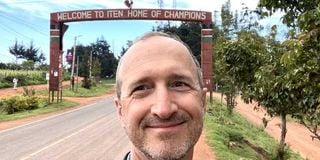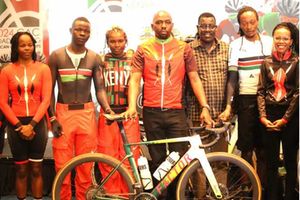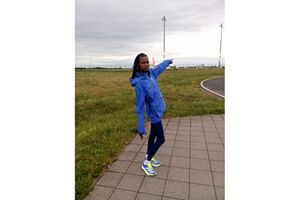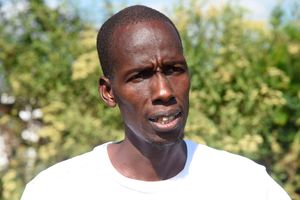
Daniel Schonpflug at Iten town
At an altitude of 2400 metres, the small town of Iten in the Rift Valley is home to the High Altitude Training Centre. Every morning at 6.30am, residents and numerous runners meet in the square on the main road for training. Daniel Schönpflug spent time with them and shares the secrets of marathon training.
‘Pole pole” is the Kiswahili word I first heard. It would prove to be a euphemism just a few minutes later.
On the day I arrive at the High Altitude Training Centre (HATC) in Iten, coach Reuben Chumba assigns me to a group of young runners who are to complete a short recovery run.
I deduce from Reuben’s hand gesture that pole pole means “slowly” in English. I bounce enthusiastically through the first kilometre between the relaxed trotting runners, who tell me that they come from Kenya and the Congo.
This is exactly how I had imagined my summer holiday would be! Then the convoy turns into a small wood.
The forest path consists of red clay and sharp stones that dig through the soles of my shoes with every step. As the first of several climbs begins, the convoy picks up the pace, chatting happily; the Congolese girls start singing. I immediately feel breathless. I feel nauseous. My legs are burning with pain. I have to let the group go.
A young man drops back with me and accompanies me back to camp. His name is Vincent, he says with a friendly smile, adding that it's quite normal to fall back, you have to get used to the mountain air first.
My dream of travelling to Africa to find out the secret of the outstanding long-distance runners must date back to the 1980s. In 1987, when I ran my first and so far only Berlin Marathon, Suleiman Nyambui from Tanzania was the first African to win the race.
Later, the winning streak of Haile Gebrselassie from Ethiopia, who won the race for four consecutive years between 2006 and 2009 and improved the world record twice in the process, was unforgettable. The Kenyan runners' run of success was already in full swing.
It began in 1995 with Sammy Lelei’s victory and culminated in recent years with the five-time victory of the exceptional athlete Eliud Kipchoge, who twice improved the world record in Berlin by decisive seconds. Seventeen of the 49 Berlin Marathons held to date have been won by Kenyans; 31 by Africans.
The African dominance is somewhat less pronounced among women, who were only officially admitted to the marathon distance in 1972. In 16 Berlin Marathons, a German runner was the first woman to cross the finish line (one of them from the GDR).
Eleven victories in the women’s race went to Ethiopian athletes — most recently to the double winner Tigist Assefa, who pulverised the women's world best time in 2023. In a total of 18 Berlin Marathons, African women have won the women’s competition.
What makes runners from Africa so strong?
The opportunity to look for an answer to this long-held question came in the summer of 2024, a few days after my 55th birthday and a few months after I had been allocated a starting place for the Berlin Marathon against all odds.
A Kenyan friend with good contacts in Iten simply wouldn't let up until all my concerns had been allayed and a place had been booked for me in a runner's camp. Not all camps are reserved for top runners.
Many — like the HATC, which was founded by Kenyan-Dutch runner Lorna Kiplagat — accommodate both Olympic champions and running enthusiasts from all over the world. So — after a marathon of vaccinations — a self-experiment begins.
The small town of Iten has about 40,000 inhabitants and is located in western Kenya at an altitude of 2400 metres in the highlands. Iten has been the capital of Elgeyo-Marakwet County since 1966, when the then President Jomo Kenyatta travelled to the town and decided that the road to Tambach, the capital at the time, was too steep and too rocky.

From the legendary Kamariny Stadium, a sandy track on the outskirts of Iten, you have a breathtaking view over the Kerio Valley, which forms a branch of the Great Rift Valley. While large herds of elephants graze down there, the plateau has been a mecca for running since the 1970s.
The history of the “Home of the Champions” began in the 1970s when Irish Father Colm O'Connell founded an athletics group at the local Saint Patrick’s High School. The best runners in the world have trained at Kamariny Stadium, including the winner of the 2014 Berlin Marathon, Denis Kipruto Kimetto.
Local running culture
There are said to be around 2000 runners in Iten and the surrounding area. No one has counted them, as most of them are organised in informal circles led by a fast leader. The majority of the region's inhabitants — like Eliud Kipchoge — belong to the Kalenjin tribe
They live mainly from agriculture. When you see the modest huts in the small maize fields, the cattle grazing along the roads, the crudely built roadside stalls with their meagre displays, the shepherd boys, the women carrying collected wood home from the forest on their backs and the many young men hoping for passengers on their boda bodas, then you understand that the living conditions are also part of the secret of the local running culture. Iten is a young town.
46 per cent of the inhabitants are under 15 years old. Vincent tells me that he — like many others in their twenties — is training for a scholarship at an American university. Like him, many people dream of running away from the maize fields.
On the first few days — with two to three training sessions a day — it becomes more and more difficult to work out how I’m going to get through the three weeks I’ve booked at the camp. I feel downright sick with exhaustion, every single muscle is burning, my feet don’t want to get used to the sharp stones and every session shows me my limits.
I fall into bed after every training session and only get out for meals. Iten may hold the secret of the fast runners, but it obviously doesn’t want to share it with me.
It is only after the first week that I gradually start to get used to the altitude. Apparently, my body has started to produce more red blood cells.
This allows my blood to transport larger amounts of oxygen to my muscles, which then carry me over the hills. At least I don't have to suffer from the heat in August.
The African winter on the equator is characterised by temperatures between 12 and 25 degrees centigrade.
In the morning, there is often fog over the fields and forests, which is not dispersed by the sun on all days. Sometimes there is heavy, cold rain.
Life in the camp follows an almost monastic rhythm. Every morning at 6.30am, the residents and numerous runners from the area meet in the square on the main road, right in front of a curio shop that carries the boastful name Olympics Corner.
The coaches divide up the groups and hand out training tasks. The secret of the fast runners remains a mystery to me, but I have at least found a strategy for my survival in the camp: I have to let the peloton get away from me in the first kilometre and stick strictly to my own pace.
Sometimes there are others who also drop back, sometimes I am alone with coach Reuben, who never lets me down.
And it is not only permissible, but even appreciated, if I pay a pacemaker for solo runs, who runs calmly alongside me, instils confidence in me and guarantees that I don’t get lost in the maze of countless dirt tracks. “Pole pole”, Reuben says time and time again and I slowly start to understand what it means: Run at your own appropriate pace!
After training in the morning, I have porridge, bananas and mandazis, crispy Kenyan doughnuts straight from the pan, for breakfast.
I learn that extensive rest between training sessions is one of the secrets of the great runners. Without extensive regeneration, weekly distances of up to 200 kilometres can hardly be achieved. The training continues in the afternoon with regenerative runs, stretching and strength training.
The camp has a state-of-the-art gym and a pool. The core training that takes place three times a week remains a moment of anxiety. The gym is filled to capacity.
Under the strict command of the coaches and equipped with nothing but a small rubber mat, the core muscles are prepared for the terrain with seemingly endless repetitions. I can't believe how slowly you can count to thirty. You can go to the sauna before dinner. Physiotherapists are on hand in case of any aches and pains.
On Tuesdays and Thursdays, runners work on their speed on the camp's tartan track and during the “Fartlek” on dirt tracks. Anyone who has ever seen about a hundred runners set off on the 17-kilometre course of this interval-training-cum-race will never forget the sight.
Nor will you forget the breathtaking pace set by the leaders of the field on the final uphill kilometres. I watch that blistering finish from the back of the Matatu that is waiting to take us back to camp.
Completely on the ball
Saturday is reserved for the long runs. Many runners take the Moiben Road a few kilometres away, which is not only paved but also far less hilly than the country roads around Iten. It is ideal for training to at least get close to the marathon distance of 42 kilometres. I also learn that here: One of the recipes of the best athletes is not only to train up to the marathon distance, but also to achieve paces that are close to their competition times. During the long runs, the view opens up to the lush green landscape in winter, the corn is already high and the woods smell of acacia.
The meals consist mainly of pasta, rice, vegetables and pulses, sometimes with chicken or goat meat. Desserts - apart from pineapple, mango and melon - are taboo, as is alcohol.
The chefs, Gladys and Mercy, also let us try Kenyan specialities: ugali, a stiff corn porridge that is distantly related to Italian polenta and which also replaces cutlery if you try to eat with your fingers like a Kenyan.
There are also plantains and sukuma wiki, the Kenyan kale that became a proverb – it was once so cheap that it helped to stretch the scarce money through the weeks, until payday.
The world comes together for the meals. The HATC can not only be booked individually, but also as a package holiday, for example with the provider Kenya Experience. In addition to top African athletes, the camp also attracts running enthusiasts from all continents. Where else would I meet a man like Kosuke Nakano from Japan?
He has been deaf since birth, but the conversation with him — via the translation app on his smartphone — is extremely lively and cheerful. He has been here alone for many months, even though his wife is expecting their first child at home. He is training hard, covering 800 km in the last month alone, to win the marathon at the first Deaf Olympics in Tokyo in autumn 2025.
A collision with a matatu that he didn’t hear coming on the road, set him back. Despite a deep cut on his arm, he returned to the track the very next day. It is stories like these that give an idea of what the secret of the fast runners is made of.
Or moments like the arrival of Beatrice Chebet, who returns to the camp from the Paris Olympics with two gold medals in the 5,000 and 10,000 metres.
The petite woman is visibly uncomfortable with all the attention. She dutifully responds to the countless requests for photos.
But the very next day, she is seen floating down the road again with two pacers and an escort vehicle.
Sometimes it’s everyday experiences that reveal facets of the puzzle. Like the morning when I am trotting alone along a side street and pass three pre-school children. They are obviously on their way back from collecting milk, because each of them is carrying one of the typical yellow plastic jerry-cans. When they see the “Mzungu”, they shout “How are you?” and start moving, squealing.
They dance effortlessly alongside me, overtake me in their broken rubber slippers and burst out laughing at the slow old man.
On one of my last days, I finally feel good enough to go for one of those long runs that are so urgently needed in marathon preparation. I meet my pacemaker Amos at sunrise.
First we run along the main street of Iten, where all the shops are still closed. Then we turn onto the stony country road. Suddenly I realise that the sharp stones no longer hurt my feet. And when we have the first ten kilometres behind us and the road winds its way up the first hill, my pulse remains steady.
Amos is running alongside me, or to be precise, one eighth of a step ahead of me. He doesn’t say much, but the way he sensitively adapts to my pace shows that he's completely on the ball. His light, rhythmic steps are like a chat that makes me forget the time. The corn fields, where the poles are already standing tall, pass by as the sun rises above the horizon. Sheep make way as we approach the herd.
We have covered 25 kilometres when the gate with the proud inscription comes into view again: “Welcome to Iten. Home of Champions.”
I had set out to find out the secret of the outstanding African runners. In the end, I realised that there really is no secret.
Just mountain air, stony paths, countless climbs, big dreams, an almost monk-like life, long years of hard work and great humility. At best, I can cut myself a very thin slice of all that.
My heart rate on my runs since returning to Berlin is twenty beats per minute lower than before the trip — I have Kenyan blood for a few weeks! But perhaps what happened in Iten in my mind is almost more important. I have understood there is the right step for every hill, no matter how steep. Pole pole.
Dr Schönpflug is Professor of History at Freie University Berlin, and Head of Academic Programs at the Wissenschaftskolleg zu Berlin / Institute of Advanced Study.











